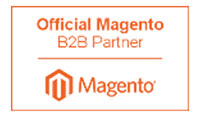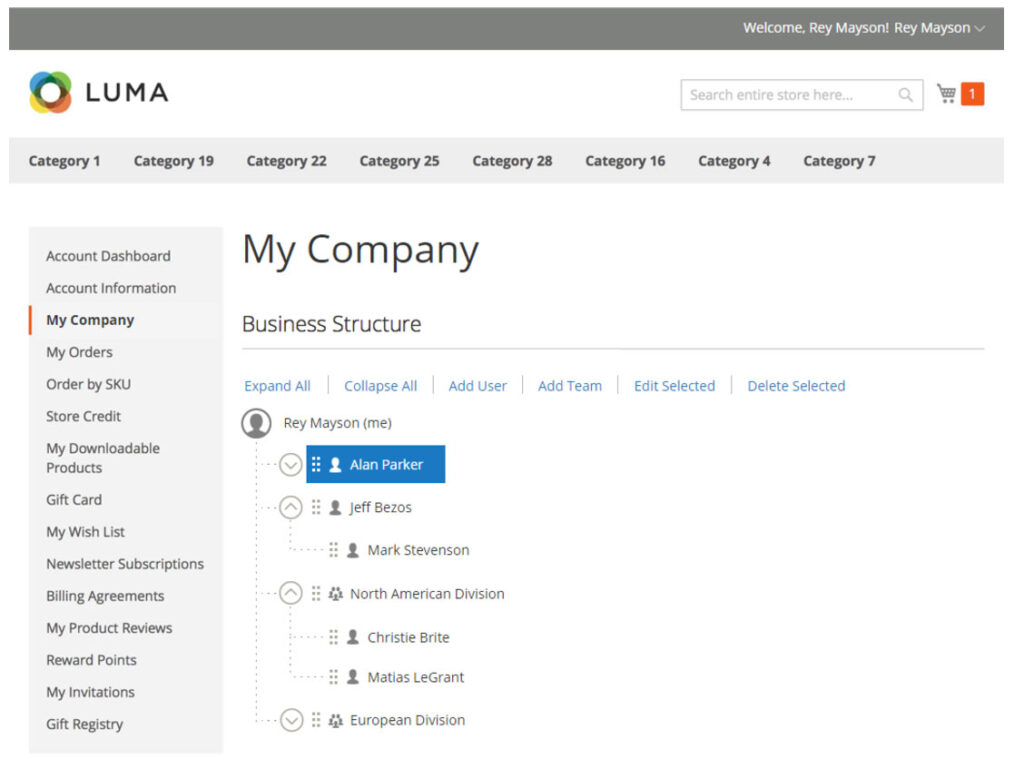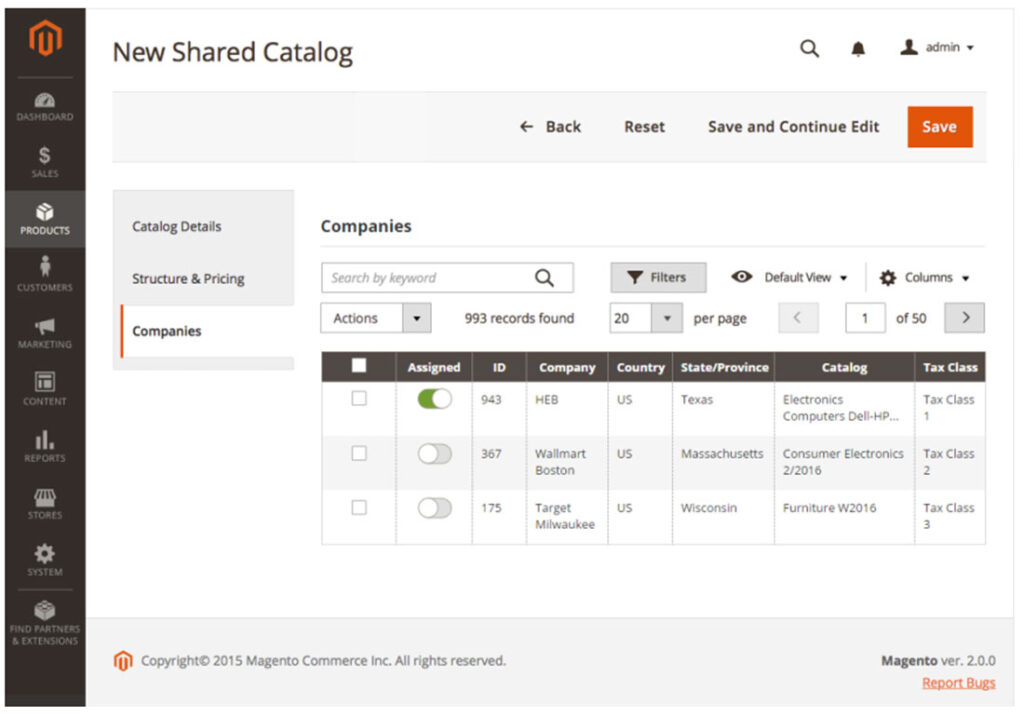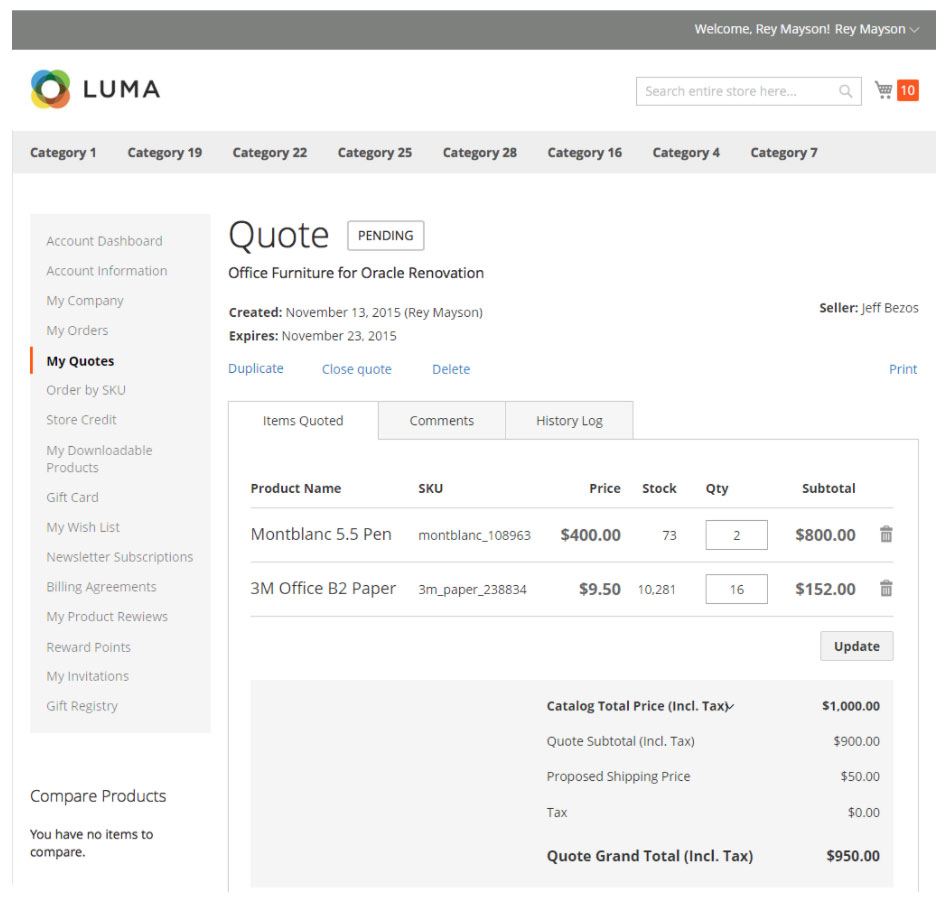A market becoming promising and mature
According to the FEVAD, B2B marketing will account for 6,700 billion dollars by 2020 and has a two digits growth every year !
This long-expected and now recognized growth has raised awareness among e-commerce platforms editors who have seen B2B as a promising market.
Editors’ positionings range from B2B-specialized to generalist platforms. Magento’s initial approach was essentially B2C. Nevertheless, thanks to its huge market coverage – more than 30% – and its successful experiences with some integrators, the editor has decided to embrace B2B.
- 86 billion online sales
- 340 billion EDI (Electronic Data Interchange)
Source: FEVAD (Insee, TIC study 2016)
- +32% growth
- 24% of the total amount of B2B sales
Source: FEVAD (Estimation Next Content – Credoc for Fevad and DGE. Studying 8 sectors excluding IT and pharmacy).
A bit of history: from the early days to the core integration
Some integrators – including us – have received demand for B2B websites very early on (since 2009 for us). Under Magento 1, the answer lied in the development of specific functional modules, some of them being very complex.
Finally, Magento has selected eight reference integrators in the world – including Clever Age, the only one in France – to support the functional design of the Enterprise version that integrates natively all B2B functionalities of the new ecommerce platform.
The approach selected and allowed by Magento 2 architecture consists in integrating directly these new functionalities as dedicated modules at the core of the platform. As a B2B reference integrator, we have worked now for more than a year on this new platform which should be officially released to the public by the end of 2017.

Quick overview of B2B specific functionalities
B2B commerce implies significant differences with B2C commerce. The examples of functionalities described below illustrate these differences very clearly. Moreover, they complement a functional scope already extensive that offers many common functionalities to both types of commerce.

Managing companies
One of the main differences with B2C: a client is no longer a physical person, but a legal entity (with its specific characteristics such as SIRET number, VAT intra-community). The users are “contacts” and belong to a legal entity.
Moreover, a company can hold different branchs and subsidiaries that needs to be differentiated while keeping this hierarchy linkage.
Magento’s B2B version allows for the management of these two elements natively while conserving the extension mechanisms and personalization by adding fields.
Besides, one of the key principles of large B2B companies is addressed: it consists in differentiating, among contacts of one company, different profiles that do not necessarily share the same rights: as a store manager, I can, for instance, make a quotation, prepare a cart, but not necessarily place an order, which may be restricted to the head of procurement. This profiles management within a company is essential to specific sales models and Magento even allows that an “administrator” contact from a client company manages autonomously the rights and accounts creations for his company’s contacts.


Price flexibility
In B2B, adapting prices depending on the client is the norm rather than the exception. Even if most companies dream of being able to apply a single price grid (needs natively addressed with user groups), the reality is very different and very often numerous clients are granted with specific prices on a product or another, a line of products, projected quantity…
This issue is now addressed with price grids allowing to define different prices for each company while conserving Magento’s very powerful promotional discounts mechanisms.

Integration to your I.S.
An e-commerce platform rarely lives all alone. In B2B, it’s not rare, it’s unprecedented: the minimum will be to interface your commercial management, very often with you ERP, your warehouse, your supply chain, or even with production tools for manufacturers.
Magento offers now OOTB many APIs that extend every new version, as well as a technical component using Rabbit MQ to facilitate asynchronous integration.

Managing a personalized catalog
In B2B commerce, business agreements made with clients often imply a limited access to the product catalog or specific prices dedicated to a specific section of the catalog. To address those specificities, Magento leverages a new concept called “shared catalog”. In a nutshell, the functionalities of the shared catalog allow users to define a customized catalog for each client, for the whole or part of the catalog. The shared catalog also allows to define for each client and each product a specific price.
Main challenges of this approach are mainly the performance of the solution and its usability on the back-end: for this last reason most of the time we most recommend to grab the shared catalog elements from the ERP or the sales software rather than administering it from the e-commerce platform itself.


Managing quotations
Managing quotations is key in B2B clients relationships. First of all, this is where prospects are engaged and enter into the conversion funnel. Secondly, it saves time to sales staff that can exchange smoothly with clients and prospects through dedicated interfaces that will store all communications history from the first quotation to the actual order. Thirdly, it’s a real service to clients that will be able to create quotations and edit them for their own final client, or store them in your platform until final signoff. Finally, it’s another communication interface to engage clients, leveraging wisely digital to support the relationship with the customer.


Managing access rights to the website
The access to the website as well as the visibility of the information are often controversial in B2B. Public or private access, prices visibility, tax free or tax included prices, public or negotiated prices, eProcurement: many possible variables that will depend on the sector and the sales strategy. With its multiples functionalities, Magento platform offers OOTB the possibility to take into account all those diverse approaches and allows a real transposition of your sales strategy into the digital channel.

And many more…
Numerous functionalities are now also available OOTB, for instance:
- Account payment: payment mode dedicated to clients that are billed periodically and not at every order
- Equipment list : dedicated to construction installers that can prepare the construction site and place orders before its effective start
- Mass updates: diverse back-office functionalities that will simplify the data update on your website
- Large volume baskets: strong specificity in B2B where it is not rare to see baskets containing over 400 different articles. A performance and ergonomy challenge.
Which business model ?
Magento B2B version’s business model is rigorously the same than EE version’s: indeed, B2B modules are an integral part of the EE version and, besides, are only available in that version.
Nevertheless, something new (given that the subscription cost to the licenses is indexed to the revenues collected by the platform): Magento has also introduced the concept of an average basket in its calculation in order not to penalize large B2B companies that often sell with average baskets significantly higher than in the B2C sector.

If you want to get a Magento 2 license EE B2B, bare in mind that a confidential cost grid has been positioned. However, the most important factor will be your discussions with the vendor, which is flexible on this topic in this new market where everything has to be done.
Which limits at this stage?
New B2B functionalities proposed by the platform are a real progress. But we always want more and here are some of our most secret wishes that we would like to become true :
- Workflow engine: to be able to adapt to the specific selling cycle of some of our clients without any development
- Unlimited company hierarchy: at this stage, only two hierarchy levels are possible for each society, which can be restrictive for some groupings where we have to set companies, their department and their services
- Performance and usability of the shared catalog: in the actual non official version, usability challenges are observed (performance being addressed with the “Mass Asynchronous Operations”)
- Managing outstanding amounts for clients with account management
- An order backlog to offer not only a view by order, but a product: delivery planning and hierarchy of product orders for all orders
- Managing orders by date: being able to order for a specific date
- Optimized management of multiple warehouses
How to position this new platform against competition ?
For everything which is not purely functional, Magento has undoubtedly considerable assets compared to its competitors:
- a very strong presence: 33% of e-commerce platforms installed in the world (top 1000 to 10.000)
- a very complete and stable platform (or almost, now with the version 2)
- an uncomparable ecosystem, either in terms of marketplace and community or in terms of integrators
- proven scalability, security measures and very good performances
- a platform which core, shared with the community, is Open Source
Regarding the functional scope, Magento is certainly becoming much better that B2C e-commerce platforms, but has only started B2B and can legitimately be considered a challenger that has to demonstrate its effectiveness.
However, in mixed B2B and B2C markets or for companies that want a platform able to offer to its clients the attractivity of B2C, Magento is becoming a must, especially with its advanced CMS functionalities (BlueFoot CMS has now become native to the platform as well as planification, versioning and previsualization of contents with staging, personalization with widgets…) and its wide functional coverage (particularly its very advanced promotions management).
In short and as always, the selection of a platform is not just about its functionalities, but about a wide range of criterias which appreciation depends on your context and your strategy… You have understood, before selecting a platform, hire the services of experts who will know how to help you to see clearly and identify strategic axis of choice, to provide an appropriate answer to your needs (by the way, we can help ;)…)





